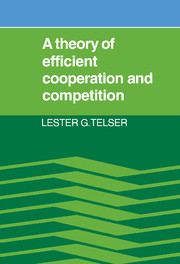Book contents
- Frontmatter
- Contents
- List of tables
- Preface
- Chapter 1 Prologue
- Chapter 2 Perceptions and reality: the genesis of the Sherman act
- Chapter 3 Competition, cooperation, and efficiency
- Chapter 4 Stable coalitions
- Chapter 5 Equilibrium with decreasing average cost: an application of the theory of the core illustrated by production and exchange among spatially separated markets
- Chapter 6 A theory of self-enforcing agreements
- Chapter 7 Some new results on duopoly applied to theories of Cournot, Bertrand, and Edgeworth
- Chapter 8 Rivalry by means of innovation
- References
- Index
Chapter 4 - Stable coalitions
Published online by Cambridge University Press: 03 November 2009
- Frontmatter
- Contents
- List of tables
- Preface
- Chapter 1 Prologue
- Chapter 2 Perceptions and reality: the genesis of the Sherman act
- Chapter 3 Competition, cooperation, and efficiency
- Chapter 4 Stable coalitions
- Chapter 5 Equilibrium with decreasing average cost: an application of the theory of the core illustrated by production and exchange among spatially separated markets
- Chapter 6 A theory of self-enforcing agreements
- Chapter 7 Some new results on duopoly applied to theories of Cournot, Bertrand, and Edgeworth
- Chapter 8 Rivalry by means of innovation
- References
- Index
Summary
STABLE COALITIONS WHOSE RETURNS ARE CONVEX FUNCTIONS
Introduction
In many important economic applications the return to a coalition is given by a convex function. For this reason the theory given here has two purposes. First, it explains which coalitions can form and survive when the return to a coalition is a convex function of its size and composition. Second, it describes the nature of the imputation of the returns to the coalition.
The size and composition of a coalition are represented by a vector in the nonnegative orthant of Rn. Let t denote such a vector. Its ith coordinate shows how many members of type i belong to the coalition represented by the vector t. Since the coordinates of t are nonnegative numbers, ti measures the size of type i membership in t. Think of a very large number of participants so that one individual is a very small fraction of the total number like him. A subcoalition of t is a vector s with 0 ≤ s ≤ t. Such a subcoalition will secede from t if it can get more doing this than by remaining in the grand coalition. Let the function f(s) denote the return to a subcoalition s so that f(t) represents the return to the whole group. The latter can divide the total return among its members so that each one of the same type i gets xi and together all members of this type get xiti.
- Type
- Chapter
- Information
- A Theory of Efficient Cooperation and Competition , pp. 74 - 143Publisher: Cambridge University PressPrint publication year: 1987



